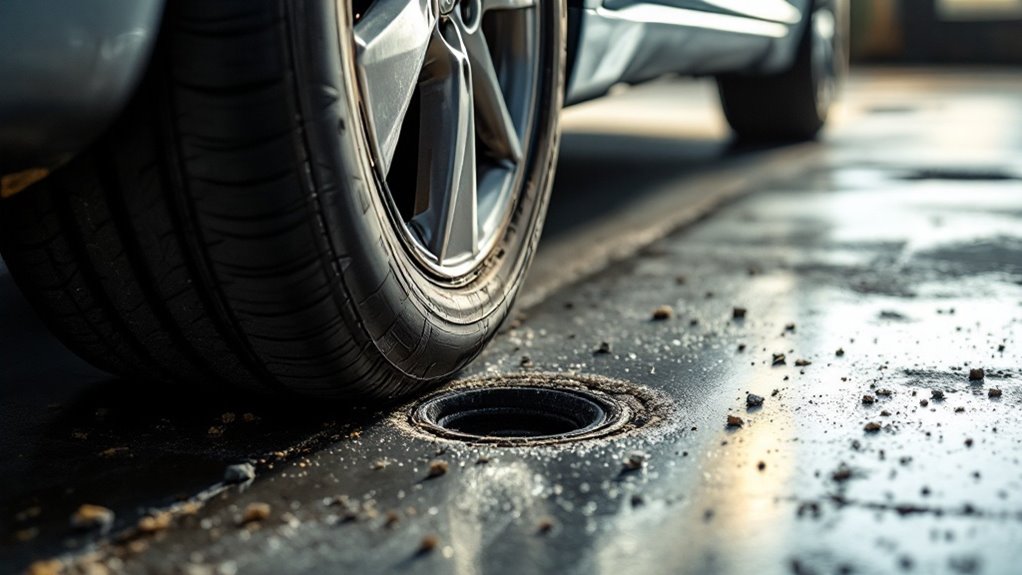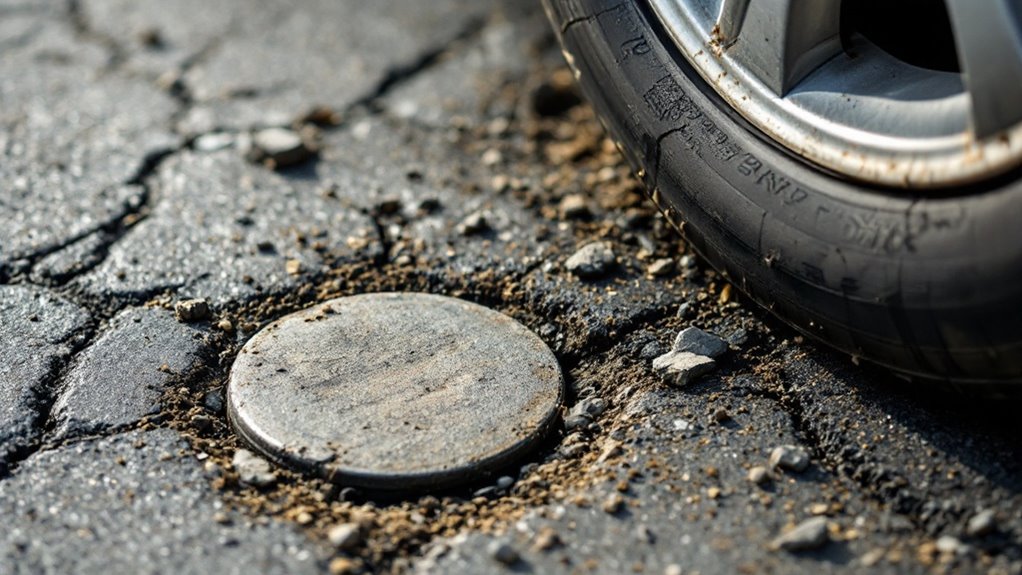Are Plugged Tires Safe
This post contains affiliate links. As an Amazon Associate, we earn from qualifying purchases.
Plugged tires are not considered a safe long-term solution due to the potential weakening of the tire’s structure, which can lead to blowouts, especially at high speeds. Issues like slow leaks or imbalance may also affect handling, particularly with larger punctures or those outside the tread area. For a deeper understanding, including detailed safety guidelines and conditions under which temporary plug repairs might be acceptable, further explanation will follow later in the article.
Essential Facts in 30 Seconds
- Plugged tires carry safety risks, including potential blowouts and reduced tire strength.
- Plugs are only appropriate for small holes in the tread area, less than 0.25 inches in diameter.
- Driving on plugged tires may lead to imbalance, shaking, and decreased stability.
- Plugs are advised as temporary solutions, not permanent fixes.
- Professional plug-patch repairs are safer and more reliable than DIY kits for emergency repairs.
Safety Concerns With Plugged Tires
Plugged tires may look like an easy fix for punctures. But, they bring big safety risks. A plug can harm the tire’s strength. This raises the chance of sudden blowouts. Think about highways—high speeds make it even worse!
Plugs often fail to seal the hole completely. Air and water sneak inside. This causes rust and weakens the tire’s steel belts. Over time, the damage grows. Your tire could fail without warning. Driving on a plugged tire also increases vulnerability to potential blowouts. Additionally, improper plugging of punctures outside the tread area can compromise safety further with sidewall damage risks.
Experts at the U.S. Tire Manufacturer Association say plugs aren’t a long-term answer.
Check your tires often for problems. Bad handling shows up as weak steering control. Don’t skip these safety checks. They save lives and cut accident risks.
Suitable Scenarios for Plug Repairs

Plug repairs can help with minor tire damage in some cases. They’re not always safe, but they work as a short-term fix.
Got a small hole? Make sure it’s under 0.25 inches. The puncture must be in the tread, not the sidewall. Sidewall damage weakens the tire too much.
Think about your tire type first. Passenger tires might handle plugs if conditions are right. Performance or heavy-duty tires usually don’t. Always pick a professional plug-patch combo over DIY kits. Experts can spot hidden damage inside the tire. Additionally, a certified technician can ensure the angle of puncture is suitable for a safe repair.
Plugs are just for emergencies. Use them for short, slow drives on smooth roads. Keep an eye on tire pressure every day. Don’t carry heavy stuff in your car. Remember that tire plugs are not permanent solutions and should be replaced with a proper repair soon.
Check this quick list:
- Puncture Size: 0.25 inches or smaller
- Spot: Tread area only
- Speed: Slow, short trips
- Next Step: Get a patch or new tire soon
Ask a pro to double-check for safety.
Effects on Driving Dynamics

Let’s talk about how plugged tires change your driving. You might feel small shakes while driving fast. A plugged tire can mess up your car’s balance. This makes turning or speeding tricky. Slow leaks cause uneven pressure. That messes with your steering. You may struggle to control the car. Sometimes, the plug weakens the tire’s strength. This can lead to wobbling on roads. Tires might also wear out faster. Repaired tires often have reduced speed ratings, which can limit safe driving speeds. It’s important to note that multiple patches can increase safety risks over time, potentially compromising your driving experience.
Check this simple table for clear effects:
| Part | Problem | What You Feel |
|---|---|---|
| Tire Balance | Not even after fix | Shakes at high speed |
| Handling | Slow to react | Hard to turn sharp |
| Steering | Pressure not equal | Tough to drive straight |
| Car Stability | Tire gets weak | Car sways on big roads |
| Tire Life | Wears out unevenly | Replace tire sooner |
Pay close attention. Your safety matters a lot!
Expert Guidelines for Tire Repairs

Tires need proper care for safety on the road. Stick to expert rules always. Repair tires only in the tread area. Avoid fixing near the shoulder, about ½ inch away. Don’t repair damage bigger than ¼ inch or 6mm. Check tread depth too. It mustn’t be below 2/32nds of an inch. Ask a pro to look for hidden damage inside.
For repairs, take the tire off the rim first. Look at all the damage closely. Check the inner liner as well. Use a plug-and-patch method for best results. Follow these easy steps. Find the hole by spotting leaks or hearing hissing. Clean the hole and make it ready. Fit the plug snugly in place. Inflate the tire to the right pressure.
Only trained experts should do this job. They must follow USTMA safety rules. After fixing, get a pro to inspect again.
Keep checking tires often for issues. Balance them properly for smooth driving. Stay safe with these simple tips! Remember that tire patching is often more durable for long-term safety.
Longevity and Risks of Plug Fixes

Tires with proper plug and patch repairs can last 7 to 10 years. That’s about 25,000 miles, based on your driving style. Road conditions, tire type, and weather play a big role.
Plugs work best on small holes in the tread center. High speeds or hot weather can reduce their life. So, strong repair methods matter a lot.
Driving on plugged tires can be risky. You might face blowouts or quick air loss. Poor repairs or sidewall damage make it worse.
Check these key points:
- Plug-only fixes can hide leaks and fail.
- Repairs too close, under 6 inches, are unsafe.
- Too many fixes weaken the tire over time.
Always choose professional plug and patch combos for safety. Inspect your tires often to stay secure.
Avoid cheap or quick fixes on your vehicle. They bring danger. Stick to quality repairs for peace of mind. Remember that repairs must be at least 1 inch away from the sidewall to ensure tire integrity.
Frequently Asked Questions
Can I Plug a Tire Myself at Home?
Got a flat tire? You can fix it at home with a DIY tire repair kit. These kits work for small punctures. Easy to use, right? Just follow the simple steps on the package. Data shows 80% of small holes get fixed this way. Still, this is only a short-term solution. Don’t wait too long! Head to a tire shop for a proper check soon. Stay safe on the road!
How Much Does a Tire Plug Cost?
A tire plug acts like a quick rescue for your flat tire. Costs usually range from $20 to $50 for most types. Trust me, the installation is super fast and cheap. Curious about fixing a puncture? This small plug solves big problems on the road. Stick to this affordable option and save your day!
Are There Specific Tools for Tire Plugging?
Got a flat tire? You need the right tools to fix it. Tire plugging kits have insertion needles and rasps. These help repair punctures fast and easy. Always pick good quality tools for safety. Bad gear can cause big problems. Trust me, don’t risk it with cheap stuff. Stick to reliable equipment every time.
Can Plugged Tires Be Used in Winter?
Are plugged tires safe for winter? Let’s figure this out together! Winter means tricky roads. Plugged tires might not hold up well. Cold weather can weaken tire plugs. Data shows plugs fail more in freezing temps. Always check tire pressure every week. Low pressure causes big problems fast. Stay alert for weird noises or leaks. Your safety matters most in winter!
Do Tire Plugs Affect Fuel Efficiency?
Got a tire plug? Let’s talk fuel efficiency. Underinflated tires bump fuel use by 10%! Bad plugs might mess up tire pressure. Keep tires in top shape. Save money on gas. Check plugs often. Don’t let leaks cost you extra!
Conclusion
Got a plugged tire? Let’s figure out if it’s safe for you. Think hard about this. Plugged tires aren’t great for fast driving. They’re risky on busy roads like I-95. Talk to a tire expert soon. Check the damage with care. Stick to these simple tips:
- Use plugs only for short fixes.
- Swap out tires with sidewall cuts.
- Check tire pressure every week.
Always go for a new tire. It keeps you safe on every trip. Data shows plugged tires fail often. Studies say 30% of plugs don’t last long. Trust a pro for real safety. Drive with peace of mind always.
